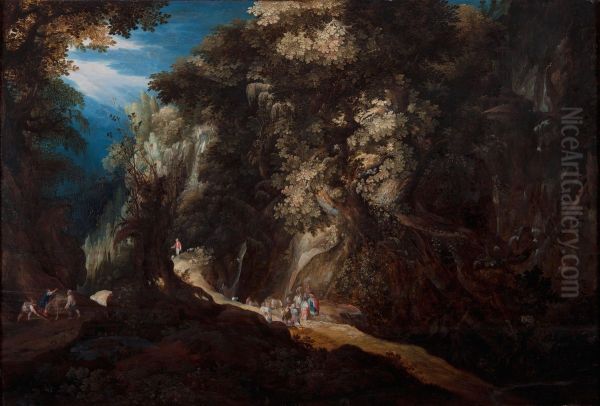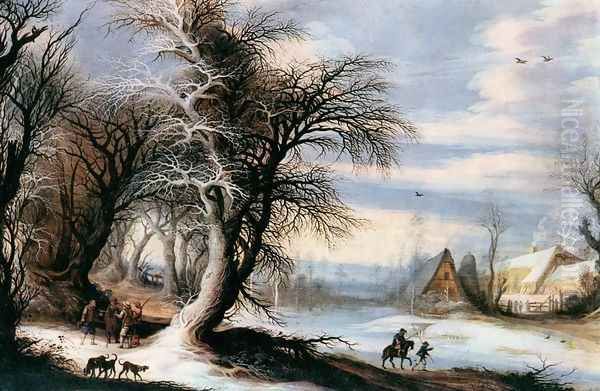Gijsbrecht Leytens, a name that resonates with the crisp air and frosted beauty of winter, stands as a distinguished figure in the annals of Flemish art. Born in Antwerp in 1586, during a period of immense artistic flourishing in the Southern Netherlands, Leytens carved a unique niche for himself, becoming celebrated primarily for his evocative and meticulously rendered winter landscapes. His lifespan, concluding around 1642 or perhaps as late as 1657, places him firmly within the vibrant artistic milieu of the early to mid-17th century, a contemporary of many great masters. Though for a considerable time his works were attributed to an anonymous hand known only as the "Master of Winter Landscapes," dedicated scholarship eventually restored his name to his remarkable oeuvre, allowing us to fully appreciate his contribution to the landscape genre.
Early Life and Artistic Emergence in Antwerp
Antwerp, at the turn of the 17th century, was a bustling metropolis and a preeminent center for arts and commerce in Europe, despite the political and religious upheavals of the preceding decades. It was into this dynamic environment that Gijsbrecht Leytens was born. While specific details about his early training remain somewhat elusive, a common path for aspiring artists of his time, it is known that he was registered as a master in the prestigious Antwerp Guild of Saint Luke in 1611. This membership was a crucial step for any artist wishing to practice independently, take on pupils, or sell their works within the city.
The artistic atmosphere of Antwerp would have been rich with influences. The legacy of earlier Netherlandish masters like Pieter Bruegel the Elder, whose iconic winter scenes and peasant life depictions had set a high bar, was pervasive. Furthermore, the development of landscape painting as an independent genre was well underway, with artists like Gillis van Coninxloo pioneering dense, wooded scenes that undoubtedly left an impression on younger painters. Leytens would have been exposed to a wide array of styles and specializations, from the detailed flower still lifes of Jan Brueghel the Elder to the grand historical and religious compositions of Peter Paul Rubens, who was a dominant figure in Antwerp during Leytens's active years.
The Signature Style: "Master of Winter Landscapes"

Gijsbrecht Leytens earned his posthumous moniker, "Master of Winter Landscapes," for a very distinct reason: his profound and consistent dedication to capturing the essence of the winter season. His paintings are not mere topographical records; they are poetic interpretations of nature in its most austere and yet strikingly beautiful state. The hallmark of a Leytens winter scene is the intricate and delicate rendering of trees, their branches often bare or lightly dusted with snow, creating a feathery, lace-like tracery against the sky. This particular feature is so characteristic that it often serves as a primary identifier of his hand.
His landscapes are typically populated, though the human figures – often woodcutters, hunters, travellers, or peasants engaged in daily activities – are usually small in scale, serving to animate the scene and provide a sense of proportion rather than being the primary focus. These figures, sometimes painted by collaborators skilled in staffage, are seamlessly integrated into the vastness of the natural world, emphasizing humanity's place within, rather than in dominion over, nature. The overall atmosphere in his works is one of serene, sometimes melancholic, stillness, a world hushed by snow and frost.
Technical Prowess and Compositional Elements
Leytens's technical skill is evident in the meticulous detail he brought to his canvases. Beyond the signature trees, his depiction of snow and ice, the textures of frozen ground, and the subtle gradations of light in a winter sky showcase a keen observational ability. He often employed a palette that, while dominated by cool blues, whites, and greys appropriate for winter, was frequently enlivened by subtle touches of warmer hues like pinks, yellows, and browns in the undergrowth, the clothing of figures, or the distant sky, preventing his scenes from becoming monotonous.
His compositional strategies often followed a pattern that lent his works a recognizable structure. Many of his landscapes feature a dense forest or a group of prominent trees in the foreground or middle ground, which then opens up to a more distant vista, often a valley, a frozen river, or a far-off village. Winding paths or frozen waterways frequently lead the viewer's eye into the depth of the painting, creating a sense of immersion. This formula, while consistent, was varied enough in its details and atmospheric effects to maintain interest and showcase his inventive capacity within his chosen specialization.

One of his notable works, Wooded Mountain Landscape with Waterfall and Travellers, currently housed in the Nationalmuseum, Stockholm, exemplifies many of these characteristics. It combines the grandeur of a mountainous setting with his typical attention to arboreal detail and the inclusion of small figures navigating the terrain. Another piece, Mountain Landscape in the Rain, demonstrates his ability to capture different weather conditions, with mist and diffused light creating a palpable sense of a damp, atmospheric environment.
The "Poet of Hoarfrost"
Leytens has also been aptly described as the "Poet of Hoarfrost." This evocative title captures the delicate, almost ethereal quality of his winter depictions. The fine, crystalline appearance of frost on branches and undergrowth is a recurring motif, rendered with such precision that it seems to shimmer on the canvas. This focus on the minute details of winter's adornment elevates his work beyond simple representation, imbuing it with a lyrical quality.
His paintings often convey a dual sense of nature's power: its capacity for breathtaking beauty and its inherent harshness. The cold is palpable, the silence profound. Yet, there is also a sense of resilience, both in the enduring forms of the trees and in the activities of the small human figures who continue their lives amidst the chill. This balance between the sublime and the challenging aspects of winter contributes to the enduring appeal of his art.
Influences, Contemporaries, and Collaborations
Gijsbrecht Leytens did not operate in an artistic vacuum. His style shows an awareness of, and dialogue with, the work of his predecessors and contemporaries. The influence of Pieter Bruegel the Elder's winter scenes, such as the famous Hunters in the Snow, is undeniable in the broader tradition of Netherlandish winter landscapes that Leytens inherited and contributed to. The detailed forest interiors pioneered by artists like Gillis van Coninxloo and later developed by Abraham Govaerts and Alexander Keirincx also find echoes in Leytens's work, particularly in his treatment of dense woodlands.
He was a contemporary of other notable landscape specialists. Joos de Momper the Younger, known for his often fantastical mountain landscapes, was active in Antwerp during the same period. While their styles differed, both contributed to the flourishing of landscape painting. Leytens is also known to have collaborated with other artists, a common practice in 17th-century Antwerp where painters often specialized. Figures in his landscapes were sometimes added by artists like Frans Francken II or Sebastiaen Vrancx, who were renowned for their skill in depicting small-scale human forms. This collaborative approach allowed each artist to contribute their specific expertise, resulting in a richer final product.
The Dutch Republic also saw a flourishing of winter landscape painting, with artists like Hendrick Avercamp and Esaias van de Velde creating lively scenes of skaters and winter festivities. While Leytens's mood is often more contemplative and less focused on bustling activity than Avercamp's, the shared interest in the winter theme across the Low Countries highlights its popularity. Other Flemish contemporaries who explored landscape, though perhaps not with Leytens's singular focus on winter, include Tobias Verhaecht, known for his mountain views, and Denis van Alsloot, who also painted winter scenes and forest landscapes. Leytens is recorded as having taught at least one pupil, Jan de Vadder, who went on to become a landscape painter and printmaker.
The Mystery of Identity and Scholarly Rediscovery
For many years, the distinctive body of work now attributed to Gijsbrecht Leytens was known only under the "Notname" (name of convenience) "Master of Winter Landscapes" (or "Meester der Winterlandschappen" in Dutch). This was due to the lack of signed works or definitive documentary evidence directly linking him to these specific paintings. It was not until 1988 that the art historian Ursula Härtung, through meticulous research and stylistic analysis, convincingly identified Gijsbrecht Leytens as the author of these characteristic winter scenes. This rediscovery was a significant moment, restoring a name and a more complete biography to a highly skilled and individualistic artist.
This period of anonymity is not uncommon in art history, especially for artists who specialized in particular genres or whose careers were not as extensively documented as those of the era's superstars like Rubens or Van Dyck. The reattribution highlights the crucial role of art historical scholarship in piecing together the past and giving due recognition to deserving artists.
Social Standing and Later Years
Beyond his artistic endeavors, Gijsbrecht Leytens appears to have been a respected member of Antwerp society. Records indicate that he served as a captain of the Antwerp civic guard (Schutterij) from 1624 to 1626. The civic guards were militias responsible for the defense and policing of the city, and holding a captaincy was a position of some social standing.
He was also a member of the "Olijftak" (Olive Branch), one of Antwerp's chambers of rhetoric (rederijkerskamers). These were dramatic societies that played an important role in the cultural and intellectual life of cities in the Low Countries, organizing performances, poetry competitions, and other literary and festive events. His involvement suggests an engagement with the broader cultural currents of his time.
Details about Leytens's later life and the exact date of his death are somewhat uncertain, with scholarly consensus placing it either around 1642 or possibly as late as 1657. Regardless, his active period spanned several decades during which he consistently produced his signature winter landscapes.
Legacy and Presence in Collections
Gijsbrecht Leytens's legacy lies in his distinctive and poetic vision of the winter landscape. He took a theme that had been explored by earlier masters and made it uniquely his own, characterized by a delicate touch, an emphasis on the intricate beauty of frosted nature, and a serene, often melancholic, atmosphere. His works offer a quiet counterpoint to the more boisterous or dramatic art of some of his contemporaries.
Today, works by Gijsbrecht Leytens can be found in several public and private collections. As mentioned, the Nationalmuseum in Stockholm holds his Wooded Mountain Landscape with Waterfall and Travellers. Another Winter landscape is part of the collection of the Bogdan and Varvara Khanenko National Museum of Arts in Kyiv. His paintings also appear on the art market, and a piece titled Winter Landscape Animated with Villagers was notably exhibited by the De Jonckheere Gallery at the FLASH art fair in Turin in 2016.
The recognition of his hand, even after a period of anonymity, ensures his place in the history of Flemish landscape painting. He remains a testament to the high degree of specialization that characterized the Antwerp art scene and to the enduring human fascination with the stark beauty of the winter world.
Conclusion: An Enduring Vision of Winter
Gijsbrecht Leytens, the "Master of Winter Landscapes" and "Poet of Hoarfrost," offers a unique window into the 17th-century appreciation of nature's seasonal transformations. His meticulous rendering of frost-laden trees, his subtle use of color and light, and the tranquil, often introspective mood of his scenes distinguish him as a master of his chosen genre. Emerging from the vibrant artistic crucible of Antwerp, he developed a highly personal style that, while influenced by the rich traditions around him, spoke with its own distinct voice. His works continue to captivate viewers with their delicate beauty and their quiet celebration of winter's crystalline magic, securing his position as a significant, if once overlooked, contributor to the golden age of Flemish painting.